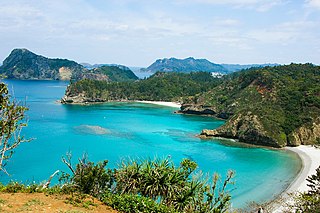
Chevrotains, or mouse-deer, are small even-toed ungulates that make up the family Tragulidae, the only extant members of the infraorder Tragulina. The 10 extant species are placed in three genera, but several species also are known only from fossils. The extant species are found in forests in South and Southeast Asia, with a single species, the water chevrotain, in the rainforests of Central and West Africa. They are solitary or live in pairs, and feed almost exclusively on plant material. Chevrotains are the smallest hoofed mammals in the world. The Asian species weigh between 0.7 and 8.0 kg, while the African chevrotain is considerably larger at 7–16 kg (15–35 lb). With an average length of 45 cm (18 in) and an average height of 30 cm (12 in), the Java mouse-deer is the smallest extant (living) ungulate or hoofed mammal, as well as the smallest extant even-toed ungulate.

The Ogasawara subtropical moist forests is a terrestrial ecoregion which encompasses the Ogasawara Archipelago of Japan. The Ogasawara Archipelago lies in the Pacific Ocean south of Honshu, Japan's largest island, and north of the Marianas Islands. The ecoregion includes the Bonin Islands and Volcano Islands chains. The islands are volcanic in origin, and have never been linked to a continent. They are home to distinct plants and animals including many endemic species.

Paradoxurus is a genus of three palm civets within the viverrid family that was denominated and first described by Frédéric Cuvier in 1822. The Paradoxurus species have a broad head, a narrow muzzle with a large rhinarium that is deeply sulcate in the middle. Their large ears are rounded at the tip. The tail is nearly as long as the head and body.

Pantherinae is a subfamily within the family Felidae; it was named and first described by Reginald Innes Pocock in 1917 as only including the Panthera species. The Pantherinae genetically diverged from a common ancestor between 9.32 to 4.47 million years ago and 10.67 to 3.76 million years ago.

Herpestes is a genus within the mongoose family Herpestidae. Several species in the family are known as slender mongooses. It is the type genus of the family, and comprises 5-6 living species, each with several subspecies. Fossil remains of three prehistoric species were excavated in France, and described in 1853.

Cleopatra ferruginea is a species of freshwater snails with an operculum, aquatic gastropod molluscs in the family Paludomidae.

Typhlatya is a genus of shrimp in the family Atyidae. These are small, stygobitic shrimp found in the West Mediterranean region, Caribbean region, Ascension Island and the Galápagos, although the individual species often have very small ranges. Species in this genus are found in salt, brackish and fresh waters, mostly in anchialine habitats and none in the open sea.

The Viverrinae represent the largest subfamily within the Viverridae comprising five genera, which are subdivided into 22 species native to Africa and Southeast Asia. This subfamily was denominated and first described by John Edward Gray in 1864.

Pachychilidae, common name pachychilids, is a taxonomic family of freshwater snails, gastropod molluscs in the clade Sorbeoconcha.

Thiara is a genus of freshwater snails, aquatic gastropod mollusks in the family Thiaridae.

Stenomelania is a genus of freshwater snails with a gill and an operculum, aquatic gastropod mollusks in the subfamily Thiarinae of the family Thiaridae known as thiarids.

Malayopython is a genus of constricting snakes in the family Pythonidae. The genus is native to India and Southeast Asia. It contains two species, both of which were previously classified within the genus Python. However, multiple studies recovered these species as distinct. Known as the "reticulatus clade", it was eventually found to be a sister lineage to a lineage giving rise to the Indo-Australian pythons rather than the genus Python.

Stenomelania denisoniensis is a very variable species of freshwater snail, an aquatic gastropod mollusk in the family Thiaridae. Stenomelania denisoniensis has a long, slender shell and small aperture. This species has a characteristic angled shoulder just below the suture. This shoulder may be strong in some individuals and weak in others even if they are part of the same population.

Stenomelania costellaris is a species of freshwater snail, an aquatic gastropod mollusk in the family Thiaridae.

Stenomelania uniformis is a species of freshwater snail, an aquatic gastropod mollusk in the family Thiaridae.
Stenomelania boninensis is a species of freshwater snail, an aquatic gastropod mollusk in the family Thiaridae.

Sermyla riqueti is a species of brackish water and freshwater snail with an operculum, an aquatic gastropod mollusk in the family Thiaridae.

Sermyla is a genus of brackish water and freshwater snails with an operculum, an aquatic gastropod mollusks in the subfamily Thiarinae of the family Thiaridae.
Stenomelania torulosa is a species of a freshwater snail, an aquatic gastropod mollusk in the family Thiaridae.

Urva is a genus comprising the Asian mongooses within the mongoose family Herpestidae. Species in the genus were formerly classified in the genus Herpestes, which is now thought to comprise exclusively African mongooses; phylogenetic evidence indicates that the Asian mongooses form a monophyletic group and had an Asian common ancestor. Urva forms a clade with Xenogale and Atilax, while Herpestes forms a clade with all other African mongoose species.

















